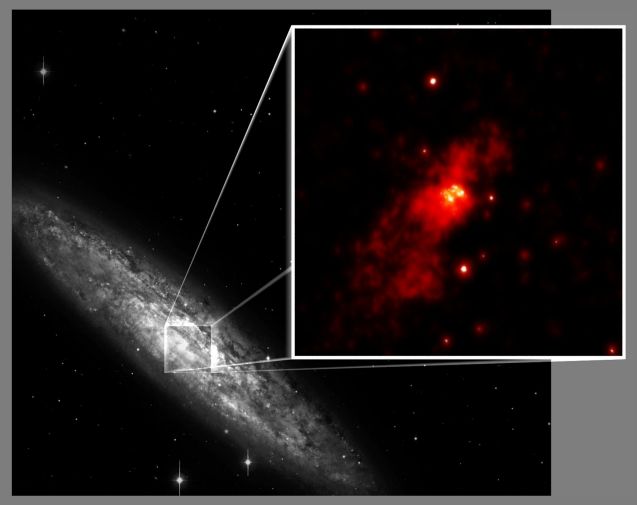Explanation: Astronomers now report that Chandra X-ray Observatory observations of galaxies known to be frantically forming stars show that these galaxies also contain luminous x-ray sources -- thought to be intermediate mass black holes and immense clouds of superheated gas. Take the lovely island universe NGC 253 for example. At distance of a mere 8 million light-years, NGC 253's prodigious starforming activity has been well studied using high-resolution optical images like the one seen here at lower left. Zooming in on this energetic galaxy's central region, Chandra's x-ray detectors reveal hidden details indicated in the inset at right. In the false-color image, x-ray hot gas clouds glow near the core and at least four very powerful x-ray sources lie within 3,000 light-years of the center of the galaxy. Much more luminous than black hole binary star systems in our own galaxy, these extreme x-ray sources may be gravitating toward NGC 253's center. As a result, NGC 253 and other similar starforming galaxies could ultimately develop a single, central, supermassive black hole, transforming their cores into quasars.
1999 2000 2001 2002 2003 2004 2005 2006 2007 2008 2009 2010 2011 2012 2013 2014 2015 2016 2017 2018 2019 2020 2021 2022 2023 2024 2025 |
Январь Февраль Март Апрель Май Июнь Июль Август Сентябрь Октябрь Ноябрь Декабрь |
NASA Web Site Statements, Warnings, and Disclaimers
NASA Official: Jay Norris. Specific rights apply.
A service of: LHEA at NASA / GSFC
& Michigan Tech. U.
|
Публикации с ключевыми словами:
черные дыры - галактика - black hole - квазары - NGC 253 - quasar - рентгеновское излучение
Публикации со словами: черные дыры - галактика - black hole - квазары - NGC 253 - quasar - рентгеновское излучение | |
См. также:
Все публикации на ту же тему >> | |
